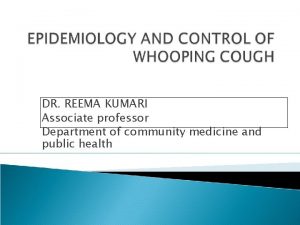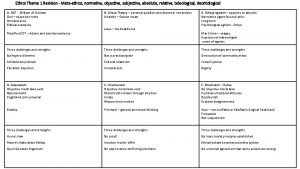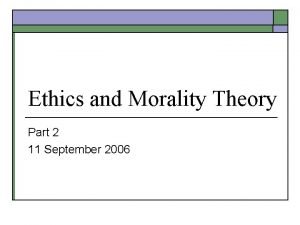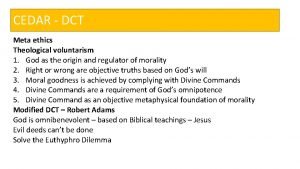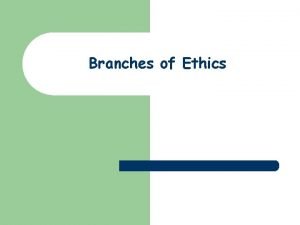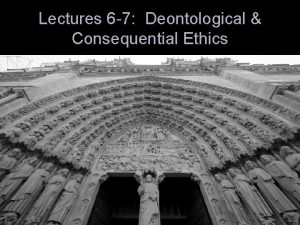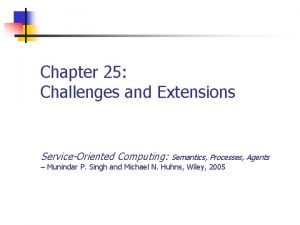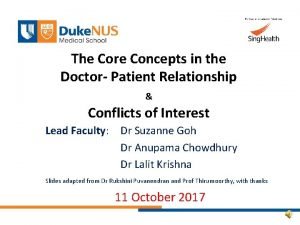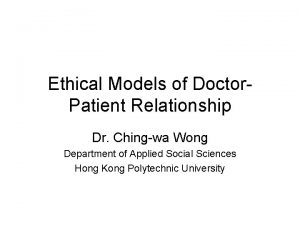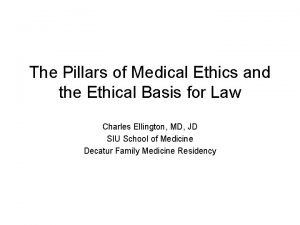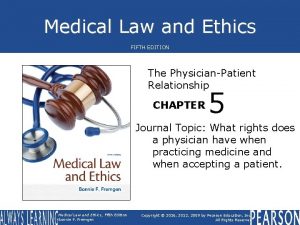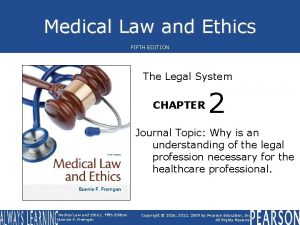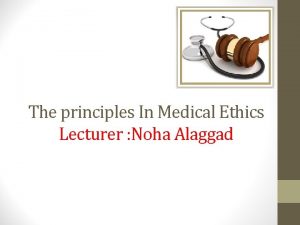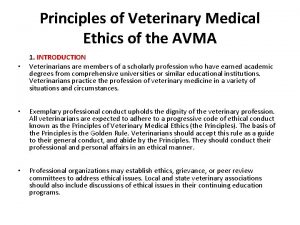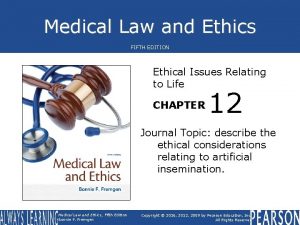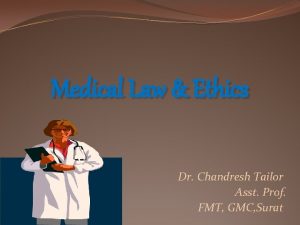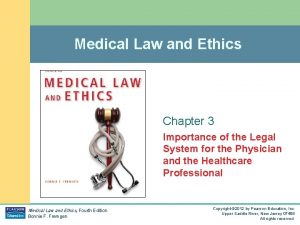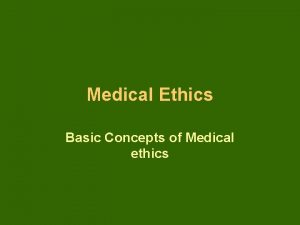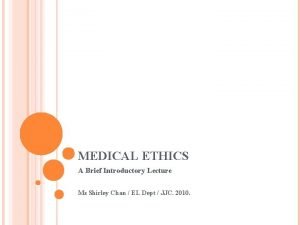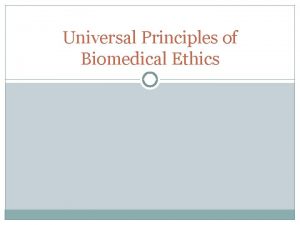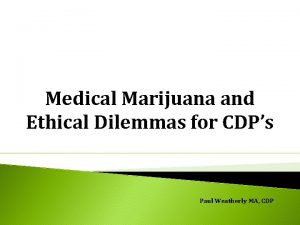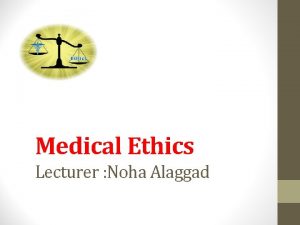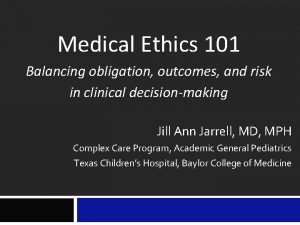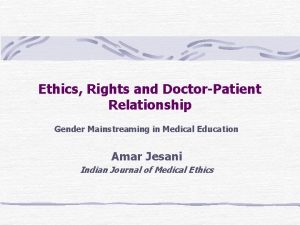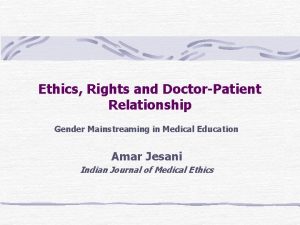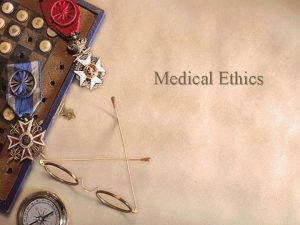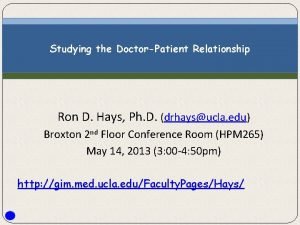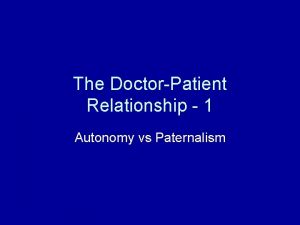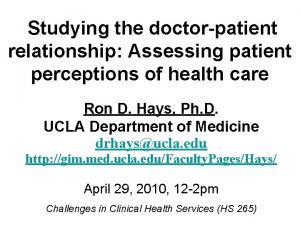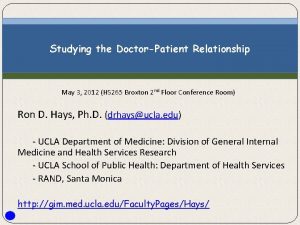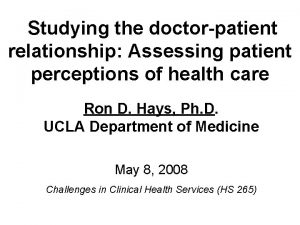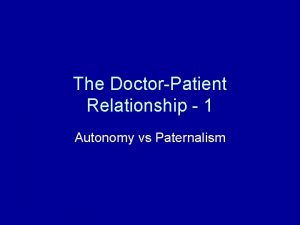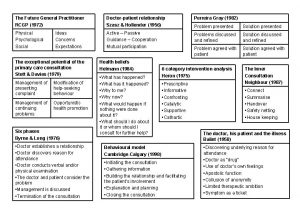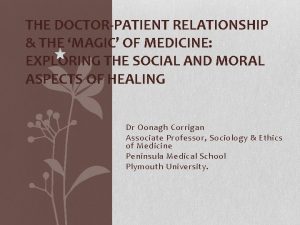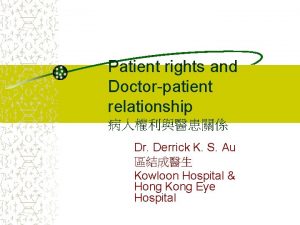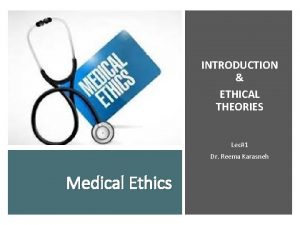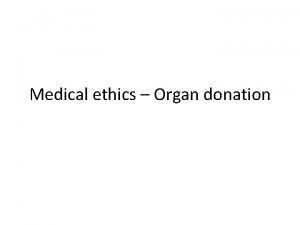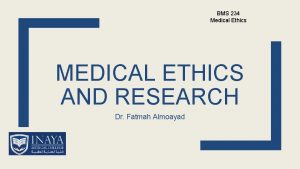Medical Ethics The DoctorPatient Relationship Lec3 Dr Reema





































- Slides: 37

Medical Ethics The Doctor–Patient Relationship Lec#3 Dr. Reema Karasneh

Medicine as a social institution • Medicine was established in response to social needs to: • Take care of the sick • Protect the social system from being misused by individual members • The success of frequent or regular meetings between doctor and patient depends on: • The doctors’ clinical knowledge and technical skills • The nature of the social relationship

Social roles of doctors and patients • Parsons (1951) was one of the earliest sociologists to examine the relationship between doctors and patients. • Talcot Parsons has identified a model of patient-physician relationship and the rights and obligation that govern this relation between parties of the social system: • Society (the public interest) • Physician • Patient

Why does it matter ? • The patient-physician relationship is fundamental for: 1. Providing excellent care 2. Promoting healing process 3. Improving outcomes • Therefore, it is important to understand what elements comprise the relationship and identify those that make it "good. "

Parsons’ model: Parsons’ “Ideal Patient” (Sick Role) • Rights (Permitted) to: 1. Allowed (and may be expected) to shed some normal activities and responsibilities (e. g. employment and household tasks) 2. Regarded as being in need of care and unable to get better by his or her own decisions and will • Obligations (In Return) : • Towards society 1. Must want to get well as quickly as possible 2. Should seek professional medical advice • Towards physician 1. Cooperate with the doctor

Parsons’ model: Doctor: profession al role Rights (Permitted) to: 1. Granted right to examine patients physically and to enquire into intimate areas of physical and personal life 2. Granted considerable autonomy in professional practice 3. Occupies position of authority in relation to the patient

• Towards society • Parsons’ model: Doctor: profession al role Physician is expected to use his expertise to determine • • Whether the person is sick or not (legitimize the illness). how serious is person sickness if sickness is curable, and when is he expected to get well. • Towards Patients • Competence: • Apply a high degree of skill and knowledge to the problems of illness • Functionally Specific: • Be guided by rules of professional practice; i. e. the doctor should not have broader contact with patients outside the medical sphere (focus only on the problem presented) • Universalism: • Use of generalized objective criteria to determine if the person is sick and how severe his sickness is. • Affectively Neutral: • Obligations (In Return) : Be objective and emotionally detached • i. e. should not judge patients’ behaviour in terms of personal value system or become emotionally involved with them (No room for likes and dislikes) • Collectivity oriented: • Act for welfare of patient and community rather than for own self-interest, desire for money, advancement, etc (put patient’s interest first)

Types of doctor-patient relationship (DPR) Types Physician control (Low) Physician control (High) Patient control (Low) Default Paternalism Patient control (High) Consumerism Mutuality

A. Paternalism The traditional form of DPR (medical consultations) A passive patient and a dominant doctor. Advantages: • More important when patients are very sick • Patients derive considerable comfort from being able to rely on the doctor in this way and being relieved of burdens of worry and decision making Disadvantages • Manipulation and exploitation of the vulnerable and ill.

B. Mutuality The optimal DPR model Equal partners in the consultation neither the patient nor the physician as standing aside Described as a ‘meeting between experts’ Exchange of ideas and sharing of belief systems Based on the communication between doctors and patients.

Mutuality. Patient’s role • Patients need to define their problems in an open and full manner. • Patients bring their own expertise in terms of their: • Experiences and explanations of their illness • Knowledge of their particular social circumstances • Attitudes to risk, values and preferences. • The patient’s right to seek care elsewhere when demands are not satisfactorily met.

Mutuality. Doctor’s role • Physicians need to work with the patient to articulate the problem and refine the request. • The doctor brings his or her clinical skills and knowledge to the consultation in terms of : • Diagnostic techniques • Knowledge of the causes of disease • Prognosis • Treatment options and preventive strategies • The physician’s right to withdraw services formally from a patient if he or she feels it is impossible to satisfy the patient’s demand.

Mutuality. Advantag es • Patients can fully understand what problem they are coping with through physicians’ help. • Physicians can entirely know patient’s value. • Decisions can easily be made from a mutual and collaborative relationship.

Mutuality. Disadvantage s • If the communication is fake, both physicians and patients do not have mutual understanding, making decision is overwhelming to a patient.

C. Consumerism Reverse of the very basic nature of the power relationship Patient: active role Doctor: passive role Acceding to the patient’s requests for a • second opinion • referral to hospital • a sick note

Consumeris m - Patient’s role • Health shoppers • Indications of consumer behaviour: • Cost-consciousness • Information seeking • Exercising independent judgement

Consumeris m - Doctor’s role • Health care providers • Technical consultant • To convince the necessity of medical services

Consumerism – Advantages & Disadvantage s • Advantages • Patients can have their own choices. • Disadvantages • When things seem to go wrong, when satisfaction is low, or when a patient suspect less than optimal care or outcome, patients are more likely to question physician authority.

D. Default Patients adopt a passive role even when the doctor reduces some of his or her control This can arise: • If patients are not aware of alternatives to a passive patient role • If patients are timid in adopting a more participative relationship

Doctor–patient relationship depends on: 1. Patient’s medical condition (different conditions and stages of illness) • E. g. Emergency situations: Paternalism 2. The expectations of doctor and of patient 3. The structural context of the consultation a. Doctor-centred b. Patient-centred

Influences on the DPR 1. 2. 3. 4. Consultation style Time Patient Structural context

1. Consultation styles: A. Doctor centered B. Patient centered

• Paternalistic - doctor is the expert and patient expected to cooperate A. Doctor centre d • Doctors focus on the physical aspects of the patients’ disease • little opportunity for patients to express their own beliefs and concerns • Doctors employ tightly controlled interviewing methods to elicit the necessary medical information and reach an organic diagnosis. • Questions are mainly of a ‘closed’ nature: • how long have you had the pain? • is it sharp or dull? • ‘Voice of medicine’

• Fostering a relationship of ‘mutuality’ • Doctors adopt a much less controlling style (less authoritarian) B. Patient centre d • Doctors spend more time actively listening to patients’ problems through • Picking up and responding to patient cues • Encouraging patients to express their own ideas or feelings • Clarifying and interpreting patients’ statements • Using a more participative style • Greater use of ‘open’ questions, interested in psycho-social aspect of illness • Tell me about the pain; How do you feel? ; What do you think is the cause of the problem? • ‘Voice of the patient’ • Communication of patients beliefs feelings & psychosocial context (bio psychosocial)

2. Influence of time • Consultations average 6 minutes (range 2 -20 min) • Pressures of time • Doctor centred ‘paternalistic’ consultation with less attention paid to the social and psychological aspects of a patient’s illness • Fewer psychological problems are identified and more prescriptions are issued • Patient centric approach needs more time but overall reduces the number of return visits & thus the total consultation time.

3. Patient characteristics and behaviours • The patient’s ability to ask questions and assume a more participative role depends on a number of factors: 1. Age • Younger people are more likely to expect a relationship of mutual participation than elderly people 2. Social and educational level • Patients with a high social and educational level tend to participate more in the consultation in terms of asking questions and asking for explanations and clarification than patients from a lower socioeconomic background and educational level

3. The course of an illness • Patients are often passive and unquestioning during initial hospital consultations, whereas by the second or third consultation they generally initiate questions themselves and take a more participative approach 4. Doctors assumptions of the interests of different patient groups • For example, there is some evidence that doctors volunteer more explanations to some groups of patients: • Male patients • More educated patients • Different languages

4. Influence of structural context • • Hospital situation Ward General practice Fee-for service

PARTNERSHIPS IN TREATMENT DECISION MAKING

Models of treatment decision-making in a doctor–patient dyad

Models of decision making • 3 models – • Paternalist • Shared • Informed

Paternalist model • The doctor, as medical expert, as solely responsible for treatment decisions with the patient expected merely to cooperate with advice and treatment.

Shared decisionmaking 1. Both doctor and patient are involved in the decision making process 2. Both parties share information 3. Both parties take steps to build a consensus about the preferred treatment 4. An agreement (consensus) is reached on the treatment to implement

Shared decision making impetus 1. Increased medical knowledge among patients 2. Prevailing social values- individual autonomy and responsibility 3. Chronic illness 4. To make choices between the treatment options and to balance risks & benefits 5. Doctors make inaccurate guesses about patients concerns & their preferences and treatment choices differ

Informed model 1. Partnership between doctor and patient 2. Doctor - information on all relevant options and their benefits and risks 3. Patient – decision making

Principle of AUTONOMY It is the ability of the person to make his or her own decisions The principle of respect for patient autonomy has had an enormous effect in changing attitudes to the doctor-patient relationship over the past 30 years. It has been used to criticize medical paternalism Has informed the development of 'patient-centred' medicine It has led to ever increasing standards in providing patients with information, and to the development of the concept of informed consent

References Scambler, Graham. Sociology As Applied to Medicine. 6 th ed. Edinburgh ; New York: Saunders/Elsevier, 2008. Myfanwy Morgan, The Doctor–Patient Relationship, Chapter 4.
 Reema kumari
Reema kumari Descriptive ethics
Descriptive ethics Normative ethical questions
Normative ethical questions Define micro and macro ethics
Define micro and macro ethics Aspects of honesty
Aspects of honesty Metaethics vs normative ethics
Metaethics vs normative ethics Descriptive ethics vs normative ethics
Descriptive ethics vs normative ethics Beneficence examples
Beneficence examples Is/ought distinction
Is/ought distinction Branches of metaethics
Branches of metaethics Consequential vs deontological
Consequential vs deontological Teleological ethics vs deontological ethics
Teleological ethics vs deontological ethics Doctor patient relationship ethics
Doctor patient relationship ethics Relationship between law and ethics
Relationship between law and ethics That's what i do
That's what i do Relationship between law and ethics
Relationship between law and ethics Objective of ethics
Objective of ethics Relationship between political science and ethics
Relationship between political science and ethics Doctor-patient relationship ethics
Doctor-patient relationship ethics Difference between rm and crm
Difference between rm and crm Pillars of medical ethics
Pillars of medical ethics Emancipated minors definition
Emancipated minors definition Medical law and ethics 5th edition
Medical law and ethics 5th edition Principle of justice in bioethics
Principle of justice in bioethics Avma code of ethics
Avma code of ethics Ethical problems in the practice of law 5th edition
Ethical problems in the practice of law 5th edition Warning notice in medical ethics
Warning notice in medical ethics Chapter 3 healthcare laws and ethics
Chapter 3 healthcare laws and ethics Concepts of medical ethics
Concepts of medical ethics Medical ethics lecture
Medical ethics lecture Ethics in medical education
Ethics in medical education Basic medical ethics
Basic medical ethics What is beneficience
What is beneficience Professional secrecy in medical ethics
Professional secrecy in medical ethics Medical marijuana ethics
Medical marijuana ethics Noha moral
Noha moral Medical ethics 101
Medical ethics 101 Hát kết hợp bộ gõ cơ thể
Hát kết hợp bộ gõ cơ thể
